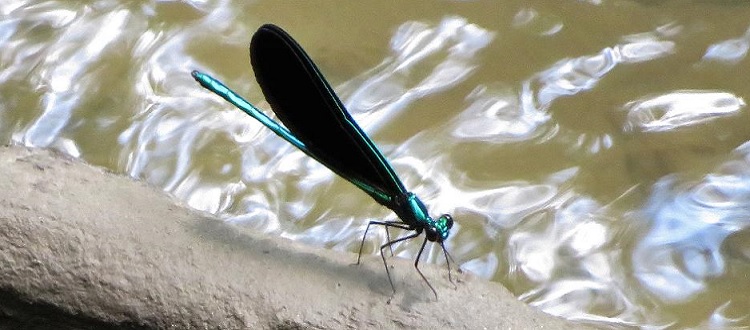Am I a dragonfly?
Known for brilliant, jewel-toned colors, damselflies can easily be mistaken for their dragonfly “cousins.” In the picture above, a beautiful, blue-green ebony jewelwing damselfly (Calopteryx maculata) suns itself on a log in the Rouge.
GET TO KNOW DAMSELFLIES
You may have seen a flying insect with a large head and wings like the one pictured above and thought dragonfly. When it lands, check to see if the wings are held close together rather than spread out and you may have a damselfly.
FUN FACT: Fossil evidence indicates that damselflies and dragonflies date back at least 100 million years and are some of the oldest known species on earth. (See an article from Smithsonian: https://www.smithsonianmag.com/smart-news/these-100-million-year-old-insects-were-just-trying-get-it-180962632
PHYSICAL CHARACTERISTICS
Damselflies and dragonflies are members of the Odonata order, a name derived from the Greek word “odonto” for tooth since both have very strong teeth and will eat any creature smaller than themselves.
Damselflies are smaller, weaker and fluttery flyers in comparison to the strong, fast flying dragonflies. As a result, the fate of damselflies all too often resembles a medieval fairy tale where an unsuspecting damsel is snatched away to doom by a fearsome dragon.
The ebony jewelwing is an especially beautiful species of damselfly commonly found in the Rouge River watershed. Adult males have iridescent blue-green bodies and black wings while females have brownish bodies and transparent bronze colored wings with a single white spot topping the edge of each wing.
HABITAT & LIFE CYCLE
Male jewelwings prefer streams and rivers with lots of shade trees, a common Rouge River type of habitat. Males vigorously defend their territories and perform complicated, aerial courtship dances to attract the ladies. After mating, the male maintains a protective watch until the female has laid her eggs on submerged vegetation or decaying wood. Eggs hatch in 1-3 weeks into aquatic nymphs that go through a series of 10 – 12 molts while living in streams for 2 months to 3 years. During this process, nymphs are both aggressive predators and frequent prey victims to fish, frogs, and birds. The surviving, mature nymphs crawl out of the water, and a final molt exposes adult wings. New adult damselflies cannot fly immediately, and they are quite vulnerable during a short period while their wings inflate, and their body hardens.
Once airborne, ebony jewelwings have a short lifespan that averages only 15 – 17 days. Since they must warm themselves in the sun to fly, they are rarely seen on cool, cloudy days. But for a few months each summer, ebony jewelwings bring a gift of joy as they flutter about on sunny days.
TAKE ACTION
Damselflies and dragonflies are sensitive to water pollution as their eggs and nymphs live in the water and they need vegetation or rotted wood in the stream to attach their eggs to. Keeping fertilizers and pesticides out of the river, adding and maintaining native shade trees along the river, and leaving wood in the river will all help these animals. Learn more about proper management and care of riparian buffer zones at our page Resources
Friends of the Rouge Community Science volunteers hunt for the nymphs of both damselflies and dragonflies during the Spring and Fall Bug Hunts as part of their work to track the health of the river. Sign up for a Bug Hunt and see them for yourself!
MAIN PHOTO CREDIT: Friends of the Rouge
